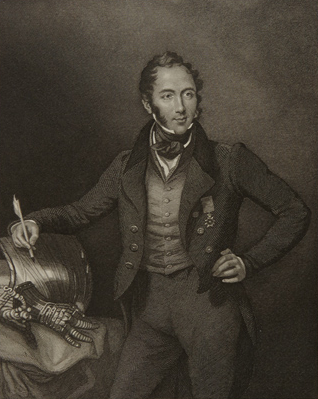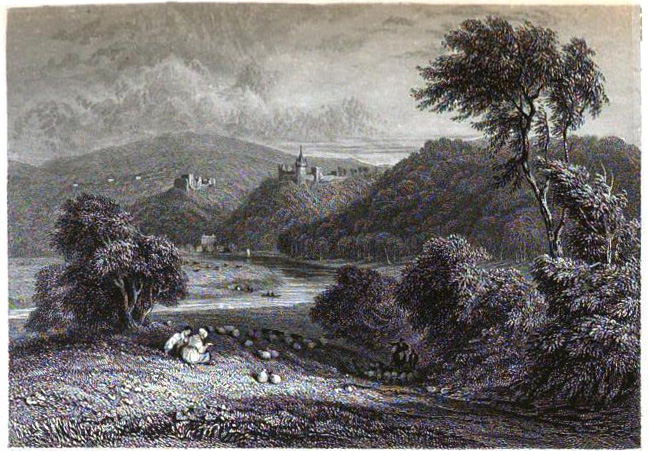Sir Samuel Meyrick on:
[Wikipedia]
[Google]
[Amazon]
 Sir Samuel Rush Meyrick, KH (16 August 1783 – 2 April 1848) was an English collector and scholar of arms and armour. He lived at
Sir Samuel Rush Meyrick, KH (16 August 1783 – 2 April 1848) was an English collector and scholar of arms and armour. He lived at
 A number of his illustrations of armour are held in the Royal Academy of Arts collection in London. His collection was used by other artists as a source of inspiration for their own work and he hosted several artists at his home in London including
A number of his illustrations of armour are held in the Royal Academy of Arts collection in London. His collection was used by other artists as a source of inspiration for their own work and he hosted several artists at his home in London including
at Forebears
*''A Critical Inquiry into Antient Armour'' (1824) *''Specimens of Ancient Furniture'' (1836
at Google Books
*''Heraldic Visitations of Wales and Part of the Marches'' (1846
at Google Books
Amgueddfa Cymru - National Museum Wales, Antiquaries in Wales
Sir Samuel Rush Meyrick
{{DEFAULTSORT:Meyrick, Samuel Rush 1783 births 1848 deaths English collectors High Sheriffs of Herefordshire Historians of weapons
 Sir Samuel Rush Meyrick, KH (16 August 1783 – 2 April 1848) was an English collector and scholar of arms and armour. He lived at
Sir Samuel Rush Meyrick, KH (16 August 1783 – 2 April 1848) was an English collector and scholar of arms and armour. He lived at Goodrich Court
Goodrich Court, Goodrich, Herefordshire, England was a 19th-century, neo-gothic castle built by the antiquarian Sir Samuel Rush Meyrick in 1828. Designed by the architect Edward Blore, the court is described by Pevsner as a "fantastic and enorm ...
, Goodrich, Herefordshire
Goodrich is a village in south Herefordshire, England close to Gloucestershire and the Forest of Dean, situated near the River Wye at . It is known for its Norman and mediaeval castle built with Old Red Sandstone.
The village of Goodrich gre ...
, and introduced systematic principles to the study of his subject.
Life
Meyrick was born in 1783 to John and Hannah Meyrick. His father had been an officer in theHonourable Artillery Company
The Honourable Artillery Company (HAC) is a reserve regiment in the British Army. Incorporated by royal charter in 1537 by King Henry VIII, it is the oldest regiment in the British Army and is considered the second-oldest military unit in the w ...
and a Fellow of the Society of Antiquaries. He was educated at Queen's College, Oxford
The Queen's College is a constituent college of the University of Oxford, England. The college was founded in 1341 by Robert de Eglesfield in honour of Philippa of Hainault. It is distinguished by its predominantly neoclassical architecture, ...
, graduating with a BA in 1804, with a MA/Bachelor of Civil Law (BCL) in 1810 and finally with a Doctor in Civil Law (DCL) in 1811. He practiced as an advocate in ecclesiastical and admiralty courts.
In 1803 Samuel eloped to Wales with Mary Parry against the wishes of his parents. He was cut out of his father's will and forced to live on a small allowance. When his father died in 1805 he left his estate to Samuel's son Llewellyn.
Samuel did inherit from his father his passion for collecting antiquities including arms and armour, and was himself elected a Fellow of the Society of Antiquaries in 1810. In the same year he published the ''History and Antiquities of the County of Cardigan''. After the death of his wife in 1818 he concentrated on developing his collection by a series of acquisitions of other collections. He was at one time owner of some locks of beard hair cut from the severed head of Charles I of England
Charles I (19 November 1600 – 30 January 1649) was King of England, Scotland, and Ireland from 27 March 1625 until his execution in 1649. He was born into the House of Stuart as the second son of King James VI of Scotland, but after hi ...
after his exhumation in 1813 during the reign of George III
George III (George William Frederick; 4 June 173829 January 1820) was King of Great Britain and of Ireland from 25 October 1760 until the union of the two kingdoms on 1 January 1801, after which he was King of the United Kingdom of Great Br ...
.
In 1824 he published his great work, the 3-volume ''A Critical Enquiry into Antient Armour as it existed in Europe, but particularly in England, from the Norman Conquest to the Reign of King Charles II, with a Glossary of Military Terms of the Middle Ages''. The book was illustrated in colour with Meyrick's own paintings, was beautifully gilded, and solidified his reputation as an authority in the study of arms and armour. With the publication of this book Meyrick hoped to rectify historical inaccuracies in the displays of armour in the Tower of London and other collections. A contemporary review of his book in the Edinburgh Review described the illustrations as "Plates as fine as the monuments of Westminster Abbey. Really and truly the work is admirably executed, and deserves every eulogy".
 A number of his illustrations of armour are held in the Royal Academy of Arts collection in London. His collection was used by other artists as a source of inspiration for their own work and he hosted several artists at his home in London including
A number of his illustrations of armour are held in the Royal Academy of Arts collection in London. His collection was used by other artists as a source of inspiration for their own work and he hosted several artists at his home in London including Eugène Delacroix
Ferdinand Victor Eugène Delacroix ( , ; 26 April 1798 – 13 August 1863) was a French Romantic artist regarded from the outset of his career as the leader of the French Romantic school.Noon, Patrick, et al., ''Crossing the Channel: Britis ...
and Richard Parkes Bonington
Richard Parkes Bonington (25 October 1802 – 23 September 1828) was an English Romantic landscape painter, who moved to France at the age of 14 and can also be considered as a French artist, and an intermediary bringing aspects of English sty ...
.
In 1828 he built Goodrich Court
Goodrich Court, Goodrich, Herefordshire, England was a 19th-century, neo-gothic castle built by the antiquarian Sir Samuel Rush Meyrick in 1828. Designed by the architect Edward Blore, the court is described by Pevsner as a "fantastic and enorm ...
, having failed to acquire nearby Goodrich Castle
Goodrich Castle is a Norman medieval castle ruin north of the village of Goodrich in Herefordshire, England, controlling a key location between Monmouth and Ross-on-Wye. It was praised by William Wordsworth as the "noblest ruin in Herefordshi ...
. There the Meyrick collection was housed in a huge armoury. After helping to reorganise the collections at the Tower of London and Windsor Castle he was knighted in 1832. In 1834 he was appointed High Sheriff of Herefordshire
This is a list of Sheriffs and, since 1998, High Sheriffs of Herefordshire
The position of Sheriff is the oldest secular office under the Crown. Formerly the Sheriff was the principal law enforcement officer in each county, but over the centurie ...
. In 1837 Llewellyn died and Samuel inherited his estate, providing the funds for yet more collection building.
Legacy
After Meyrick's death in 1848, Goodrich Court and the Meyrick collection passed to his cousin Augustus Meyrick, who exhibited the collection in 1869 at what is now theVictoria and Albert Museum
The Victoria and Albert Museum (often abbreviated as the V&A) in London is the world's largest museum of applied arts, decorative arts and design, housing a permanent collection of over 2.27 million objects. It was founded in 1852 and nam ...
. Augustus subsequently offered the collection to the British Government, and donated some objects to the British Museum
The British Museum is a public museum dedicated to human history, art and culture located in the Bloomsbury area of London. Its permanent collection of eight million works is among the largest and most comprehensive in existence. It docum ...
, but ultimately disposed of much of it to various private purchasers. Many important items were acquired by the antiquarian, Augustus Wollaston Franks
Sir Augustus Wollaston Franks (20 March 182621 May 1897) was a British antiquarian and museum administrator. Franks was described by Marjorie Caygill, historian of the British Museum, as "arguably the most important collector in the history of ...
, who later donated these too to the British Museum
The British Museum is a public museum dedicated to human history, art and culture located in the Bloomsbury area of London. Its permanent collection of eight million works is among the largest and most comprehensive in existence. It docum ...
. Other significant pieces from the collection were bought by a Parisian dealer named Frédéric Spitzer and sold to Sir Richard Wallace
Sir Richard Wallace, 1st Baronet (21 June 1818 – 20 July 1890), of Sudbourne, Sudbourne Hall in Suffolk, Hertford House in London, and of the Château de Bagatelle in Paris, was a British art collector and Francophile.
Origins and youth
Ric ...
and are now held in the Wallace Collection
The Wallace Collection is a museum in London occupying Hertford House in Manchester Square, the former townhouse of the Seymour family, Marquesses of Hertford. It is named after Sir Richard Wallace, who built the extensive collection, along ...
in London.
Tobias Capwell
Tobias Emanuel ("Toby") Capwell FSA (born ) is an American historian who lives and works in London. His principal interest is in European arms and armour of the medieval and Renaissance periods (roughly, the 12th century to the 16th). He is Cur ...
, the curator of arms and armour at the Wallace Collection acknowledged Meyrick's contribution to the study of arms and armour by describing him as "The first and greatest of those giants on whose shoulders we stand."
Works
*''The Costume of the Original Inhabitants of the British Islands'' (1810) *''The History and Antiquities of the County of Cardigan'' (1810at Forebears
*''A Critical Inquiry into Antient Armour'' (1824) *''Specimens of Ancient Furniture'' (1836
at Google Books
*''Heraldic Visitations of Wales and Part of the Marches'' (1846
at Google Books
Collection
Meyrick's collection of arms and armour included the following pieces: *Meyrick Helmet
The Meyrick Helmet is an Iron Age bronze peaked helmet, with La Tène style decoration, that is held at the British Museum in London. It is one of only four Iron Age helmets to have been discovered in Britain, the other three being the more famou ...
* Witham Shield
The Witham Shield is an Iron Age decorative bronze shield facing of La Tène style, dating from about the 4th century BC. The shield was discovered in the River Witham in the vicinity of Washingborough and Fiskerton in Lincolnshire, England in 182 ...
References
* Lowe, Rosalind (2005) ''Sir Samuel Meyrick and Goodrich Court''. Logaston PressExternal links
Amgueddfa Cymru - National Museum Wales, Antiquaries in Wales
Sir Samuel Rush Meyrick
{{DEFAULTSORT:Meyrick, Samuel Rush 1783 births 1848 deaths English collectors High Sheriffs of Herefordshire Historians of weapons